PROJ6003 Project Execution: Glasgow Science Centre Tower Risk Report
VerifiedAdded on 2023/06/13
|8
|1484
|459
Report
AI Summary
This report provides a comprehensive analysis of risk management strategies applied to the Glasgow Science Centre Tower project (GSCT). It identifies various technical, schedule, environmental, external, safety, budget, and construction design risks associated with the project. A risk register and severity matrix are included to prioritize risks. The report also outlines risk response strategies such as mitigation and acceptance, along with a communication plan to inform stakeholders of ongoing changes. Ultimately, the report aims to provide insights into minimizing risks and enhancing project delivery, emphasizing the importance of proactive risk management in construction projects. Desklib provides access to similar reports and study resources for students.
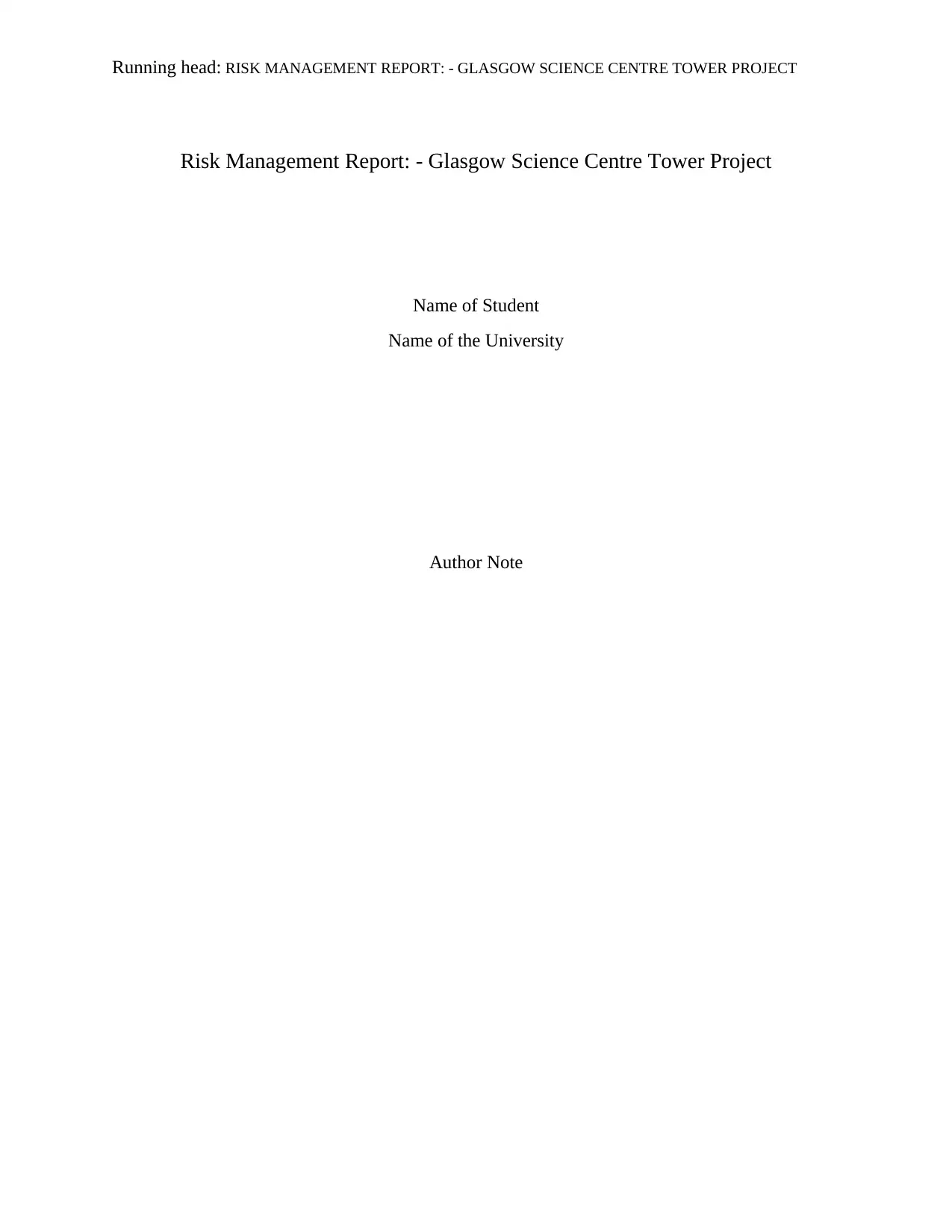
Running head: RISK MANAGEMENT REPORT: - GLASGOW SCIENCE CENTRE TOWER PROJECT
Risk Management Report: - Glasgow Science Centre Tower Project
Name of Student
Name of the University
Author Note
Risk Management Report: - Glasgow Science Centre Tower Project
Name of Student
Name of the University
Author Note
Paraphrase This Document
Need a fresh take? Get an instant paraphrase of this document with our AI Paraphraser
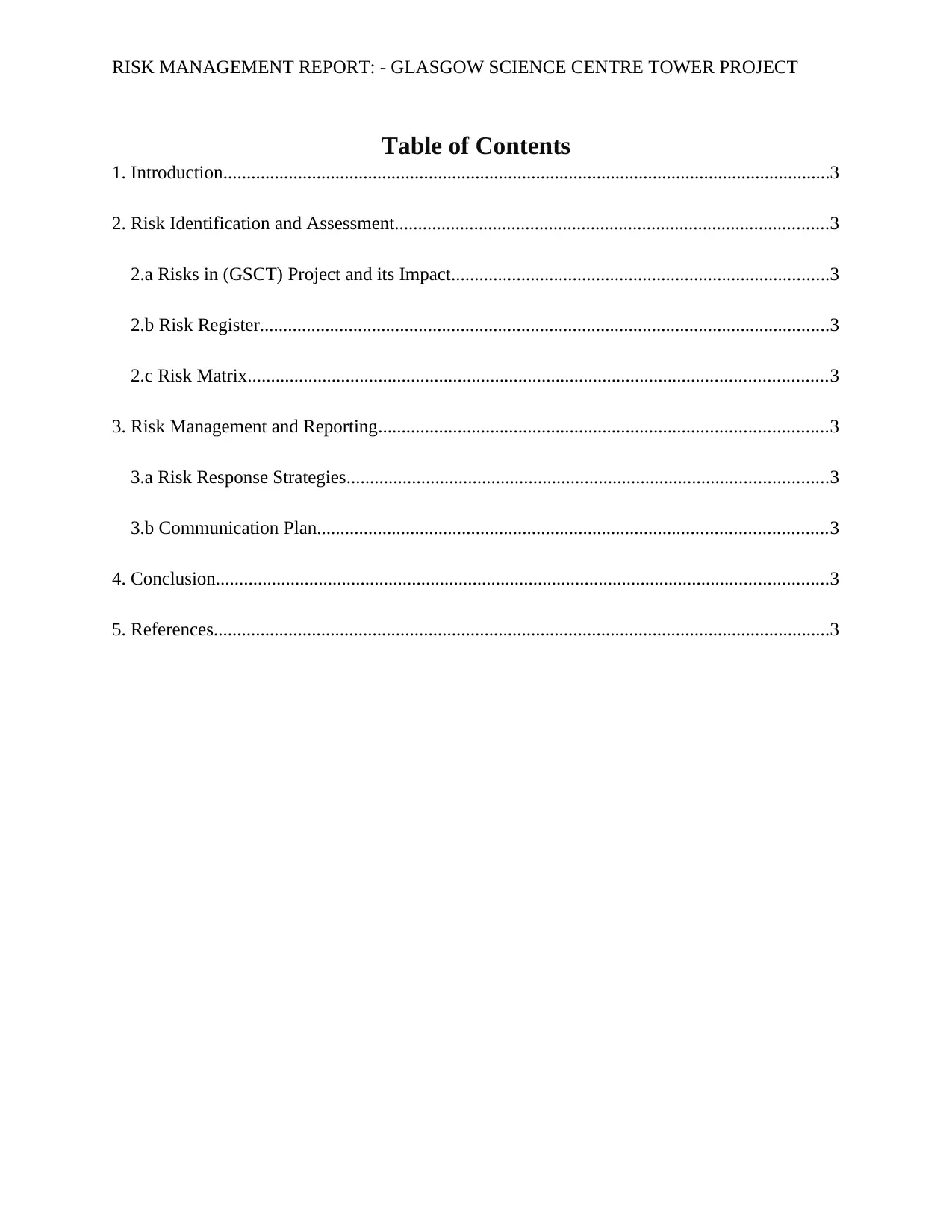
RISK MANAGEMENT REPORT: - GLASGOW SCIENCE CENTRE TOWER PROJECT
Table of Contents
1. Introduction..................................................................................................................................3
2. Risk Identification and Assessment.............................................................................................3
2.a Risks in (GSCT) Project and its Impact.................................................................................3
2.b Risk Register..........................................................................................................................3
2.c Risk Matrix............................................................................................................................3
3. Risk Management and Reporting................................................................................................3
3.a Risk Response Strategies.......................................................................................................3
3.b Communication Plan.............................................................................................................3
4. Conclusion...................................................................................................................................3
5. References....................................................................................................................................3
Table of Contents
1. Introduction..................................................................................................................................3
2. Risk Identification and Assessment.............................................................................................3
2.a Risks in (GSCT) Project and its Impact.................................................................................3
2.b Risk Register..........................................................................................................................3
2.c Risk Matrix............................................................................................................................3
3. Risk Management and Reporting................................................................................................3
3.a Risk Response Strategies.......................................................................................................3
3.b Communication Plan.............................................................................................................3
4. Conclusion...................................................................................................................................3
5. References....................................................................................................................................3
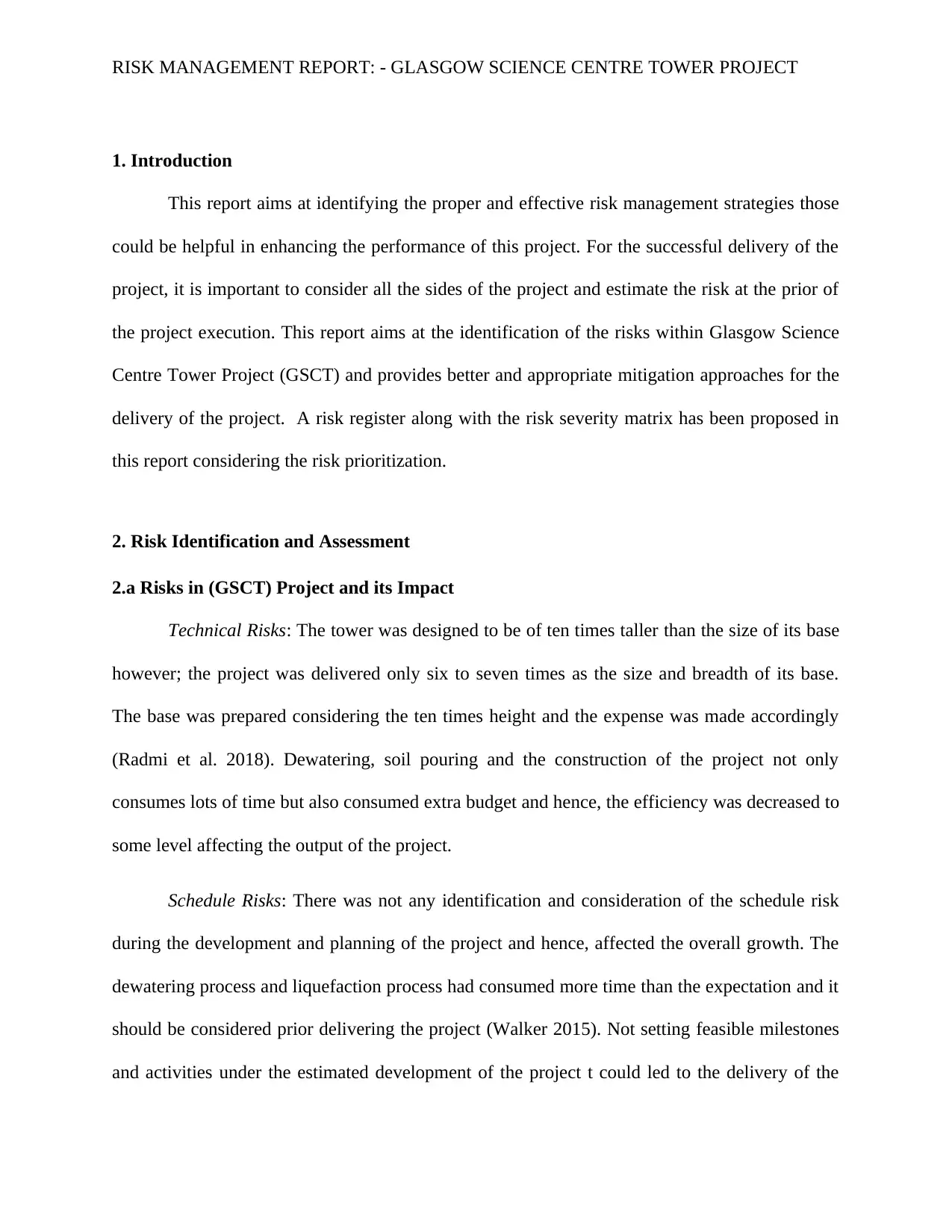
RISK MANAGEMENT REPORT: - GLASGOW SCIENCE CENTRE TOWER PROJECT
1. Introduction
This report aims at identifying the proper and effective risk management strategies those
could be helpful in enhancing the performance of this project. For the successful delivery of the
project, it is important to consider all the sides of the project and estimate the risk at the prior of
the project execution. This report aims at the identification of the risks within Glasgow Science
Centre Tower Project (GSCT) and provides better and appropriate mitigation approaches for the
delivery of the project. A risk register along with the risk severity matrix has been proposed in
this report considering the risk prioritization.
2. Risk Identification and Assessment
2.a Risks in (GSCT) Project and its Impact
Technical Risks: The tower was designed to be of ten times taller than the size of its base
however; the project was delivered only six to seven times as the size and breadth of its base.
The base was prepared considering the ten times height and the expense was made accordingly
(Radmi et al. 2018). Dewatering, soil pouring and the construction of the project not only
consumes lots of time but also consumed extra budget and hence, the efficiency was decreased to
some level affecting the output of the project.
Schedule Risks: There was not any identification and consideration of the schedule risk
during the development and planning of the project and hence, affected the overall growth. The
dewatering process and liquefaction process had consumed more time than the expectation and it
should be considered prior delivering the project (Walker 2015). Not setting feasible milestones
and activities under the estimated development of the project t could led to the delivery of the
1. Introduction
This report aims at identifying the proper and effective risk management strategies those
could be helpful in enhancing the performance of this project. For the successful delivery of the
project, it is important to consider all the sides of the project and estimate the risk at the prior of
the project execution. This report aims at the identification of the risks within Glasgow Science
Centre Tower Project (GSCT) and provides better and appropriate mitigation approaches for the
delivery of the project. A risk register along with the risk severity matrix has been proposed in
this report considering the risk prioritization.
2. Risk Identification and Assessment
2.a Risks in (GSCT) Project and its Impact
Technical Risks: The tower was designed to be of ten times taller than the size of its base
however; the project was delivered only six to seven times as the size and breadth of its base.
The base was prepared considering the ten times height and the expense was made accordingly
(Radmi et al. 2018). Dewatering, soil pouring and the construction of the project not only
consumes lots of time but also consumed extra budget and hence, the efficiency was decreased to
some level affecting the output of the project.
Schedule Risks: There was not any identification and consideration of the schedule risk
during the development and planning of the project and hence, affected the overall growth. The
dewatering process and liquefaction process had consumed more time than the expectation and it
should be considered prior delivering the project (Walker 2015). Not setting feasible milestones
and activities under the estimated development of the project t could led to the delivery of the
⊘ This is a preview!⊘
Do you want full access?
Subscribe today to unlock all pages.

Trusted by 1+ million students worldwide
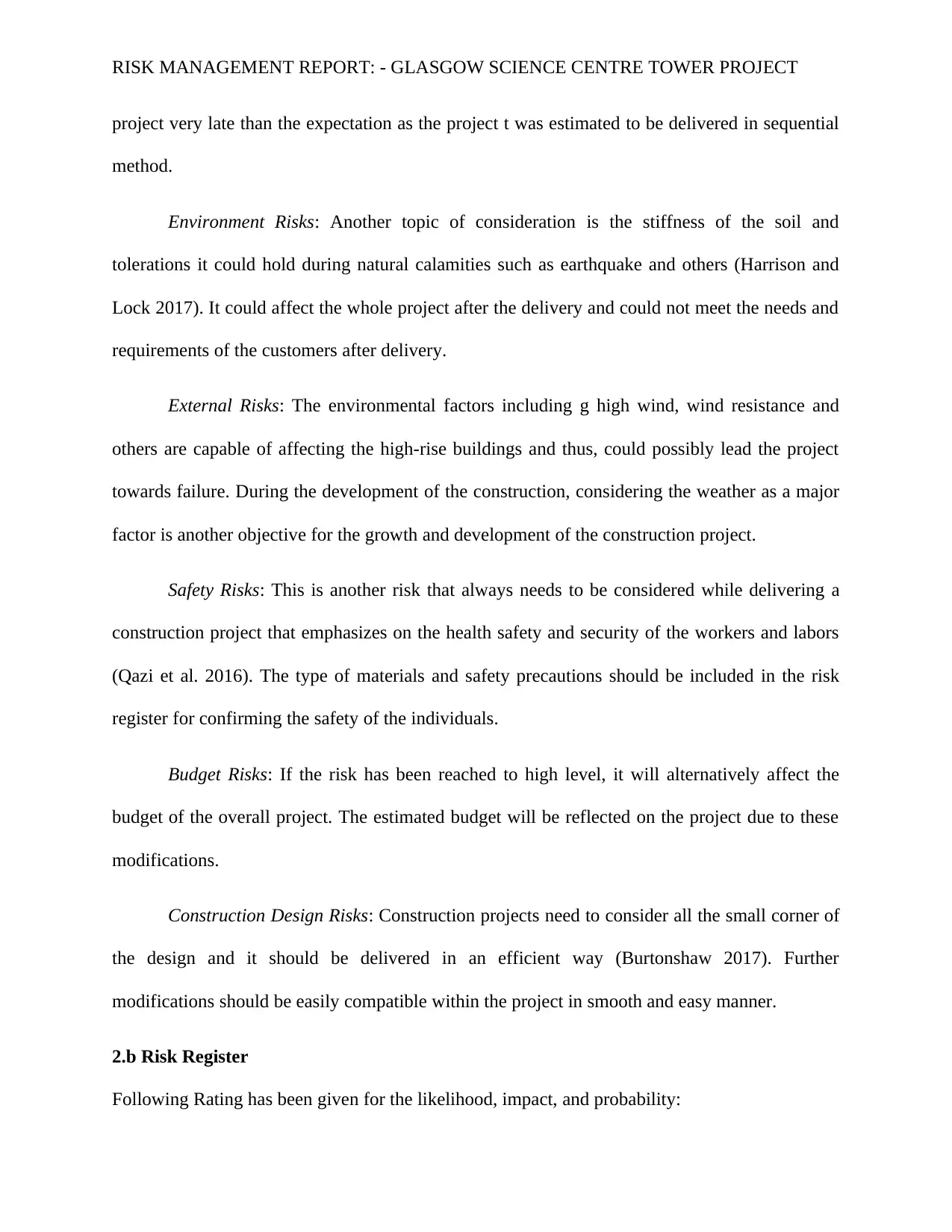
RISK MANAGEMENT REPORT: - GLASGOW SCIENCE CENTRE TOWER PROJECT
project very late than the expectation as the project t was estimated to be delivered in sequential
method.
Environment Risks: Another topic of consideration is the stiffness of the soil and
tolerations it could hold during natural calamities such as earthquake and others (Harrison and
Lock 2017). It could affect the whole project after the delivery and could not meet the needs and
requirements of the customers after delivery.
External Risks: The environmental factors including g high wind, wind resistance and
others are capable of affecting the high-rise buildings and thus, could possibly lead the project
towards failure. During the development of the construction, considering the weather as a major
factor is another objective for the growth and development of the construction project.
Safety Risks: This is another risk that always needs to be considered while delivering a
construction project that emphasizes on the health safety and security of the workers and labors
(Qazi et al. 2016). The type of materials and safety precautions should be included in the risk
register for confirming the safety of the individuals.
Budget Risks: If the risk has been reached to high level, it will alternatively affect the
budget of the overall project. The estimated budget will be reflected on the project due to these
modifications.
Construction Design Risks: Construction projects need to consider all the small corner of
the design and it should be delivered in an efficient way (Burtonshaw 2017). Further
modifications should be easily compatible within the project in smooth and easy manner.
2.b Risk Register
Following Rating has been given for the likelihood, impact, and probability:
project very late than the expectation as the project t was estimated to be delivered in sequential
method.
Environment Risks: Another topic of consideration is the stiffness of the soil and
tolerations it could hold during natural calamities such as earthquake and others (Harrison and
Lock 2017). It could affect the whole project after the delivery and could not meet the needs and
requirements of the customers after delivery.
External Risks: The environmental factors including g high wind, wind resistance and
others are capable of affecting the high-rise buildings and thus, could possibly lead the project
towards failure. During the development of the construction, considering the weather as a major
factor is another objective for the growth and development of the construction project.
Safety Risks: This is another risk that always needs to be considered while delivering a
construction project that emphasizes on the health safety and security of the workers and labors
(Qazi et al. 2016). The type of materials and safety precautions should be included in the risk
register for confirming the safety of the individuals.
Budget Risks: If the risk has been reached to high level, it will alternatively affect the
budget of the overall project. The estimated budget will be reflected on the project due to these
modifications.
Construction Design Risks: Construction projects need to consider all the small corner of
the design and it should be delivered in an efficient way (Burtonshaw 2017). Further
modifications should be easily compatible within the project in smooth and easy manner.
2.b Risk Register
Following Rating has been given for the likelihood, impact, and probability:
Paraphrase This Document
Need a fresh take? Get an instant paraphrase of this document with our AI Paraphraser
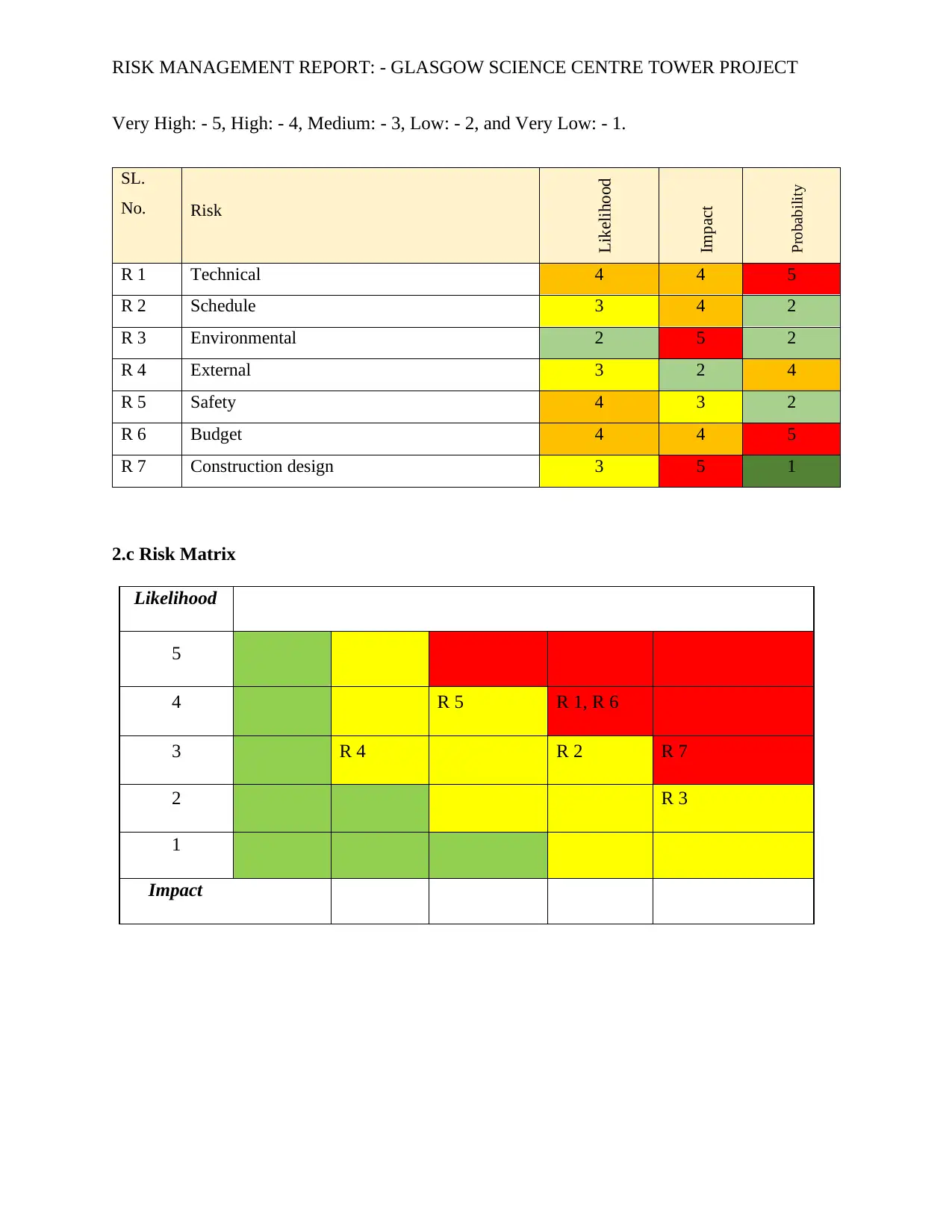
RISK MANAGEMENT REPORT: - GLASGOW SCIENCE CENTRE TOWER PROJECT
Very High: - 5, High: - 4, Medium: - 3, Low: - 2, and Very Low: - 1.
SL.
No. Risk
Likelihood
Impact
Probability
R 1 Technical 4 4 5
R 2 Schedule 3 4 2
R 3 Environmental 2 5 2
R 4 External 3 2 4
R 5 Safety 4 3 2
R 6 Budget 4 4 5
R 7 Construction design 3 5 1
2.c Risk Matrix
Likelihood
5
4 R 5 R 1, R 6
3 R 4 R 2 R 7
2 R 3
1
Impact
Very High: - 5, High: - 4, Medium: - 3, Low: - 2, and Very Low: - 1.
SL.
No. Risk
Likelihood
Impact
Probability
R 1 Technical 4 4 5
R 2 Schedule 3 4 2
R 3 Environmental 2 5 2
R 4 External 3 2 4
R 5 Safety 4 3 2
R 6 Budget 4 4 5
R 7 Construction design 3 5 1
2.c Risk Matrix
Likelihood
5
4 R 5 R 1, R 6
3 R 4 R 2 R 7
2 R 3
1
Impact
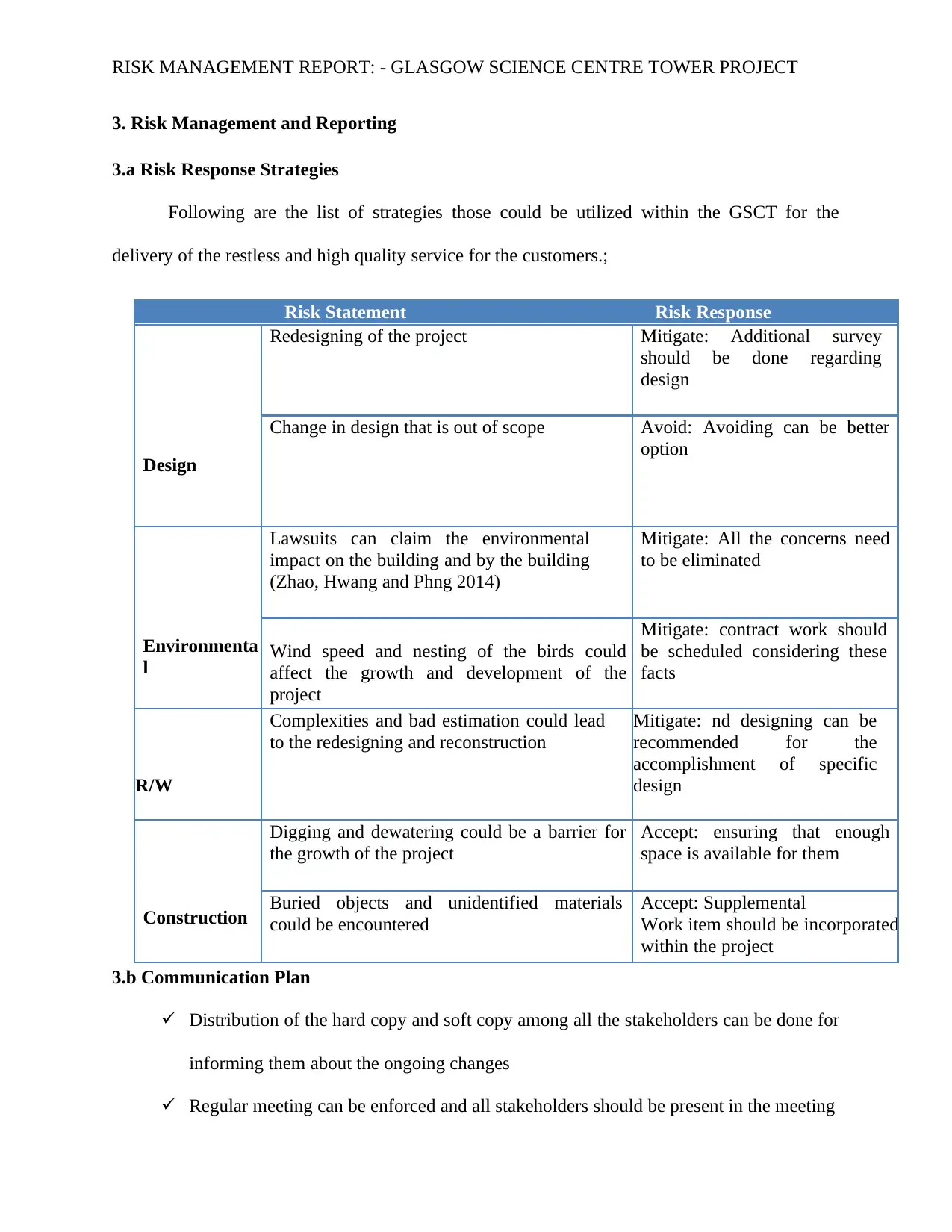
RISK MANAGEMENT REPORT: - GLASGOW SCIENCE CENTRE TOWER PROJECT
3. Risk Management and Reporting
3.a Risk Response Strategies
Following are the list of strategies those could be utilized within the GSCT for the
delivery of the restless and high quality service for the customers.;
Risk Statement Risk Response
Design
Redesigning of the project Mitigate: Additional survey
should be done regarding
design
Change in design that is out of scope Avoid: Avoiding can be better
option
Environmenta
l
Lawsuits can claim the environmental
impact on the building and by the building
(Zhao, Hwang and Phng 2014)
Mitigate: All the concerns need
to be eliminated
Wind speed and nesting of the birds could
affect the growth and development of the
project
Mitigate: contract work should
be scheduled considering these
facts
R/W
Complexities and bad estimation could lead
to the redesigning and reconstruction
Mitigate: nd designing can be
recommended for the
accomplishment of specific
design
Construction
Digging and dewatering could be a barrier for
the growth of the project
Accept: ensuring that enough
space is available for them
Buried objects and unidentified materials
could be encountered
Accept: Supplemental
Work item should be incorporated
within the project
3.b Communication Plan
Distribution of the hard copy and soft copy among all the stakeholders can be done for
informing them about the ongoing changes
Regular meeting can be enforced and all stakeholders should be present in the meeting
3. Risk Management and Reporting
3.a Risk Response Strategies
Following are the list of strategies those could be utilized within the GSCT for the
delivery of the restless and high quality service for the customers.;
Risk Statement Risk Response
Design
Redesigning of the project Mitigate: Additional survey
should be done regarding
design
Change in design that is out of scope Avoid: Avoiding can be better
option
Environmenta
l
Lawsuits can claim the environmental
impact on the building and by the building
(Zhao, Hwang and Phng 2014)
Mitigate: All the concerns need
to be eliminated
Wind speed and nesting of the birds could
affect the growth and development of the
project
Mitigate: contract work should
be scheduled considering these
facts
R/W
Complexities and bad estimation could lead
to the redesigning and reconstruction
Mitigate: nd designing can be
recommended for the
accomplishment of specific
design
Construction
Digging and dewatering could be a barrier for
the growth of the project
Accept: ensuring that enough
space is available for them
Buried objects and unidentified materials
could be encountered
Accept: Supplemental
Work item should be incorporated
within the project
3.b Communication Plan
Distribution of the hard copy and soft copy among all the stakeholders can be done for
informing them about the ongoing changes
Regular meeting can be enforced and all stakeholders should be present in the meeting
⊘ This is a preview!⊘
Do you want full access?
Subscribe today to unlock all pages.

Trusted by 1+ million students worldwide
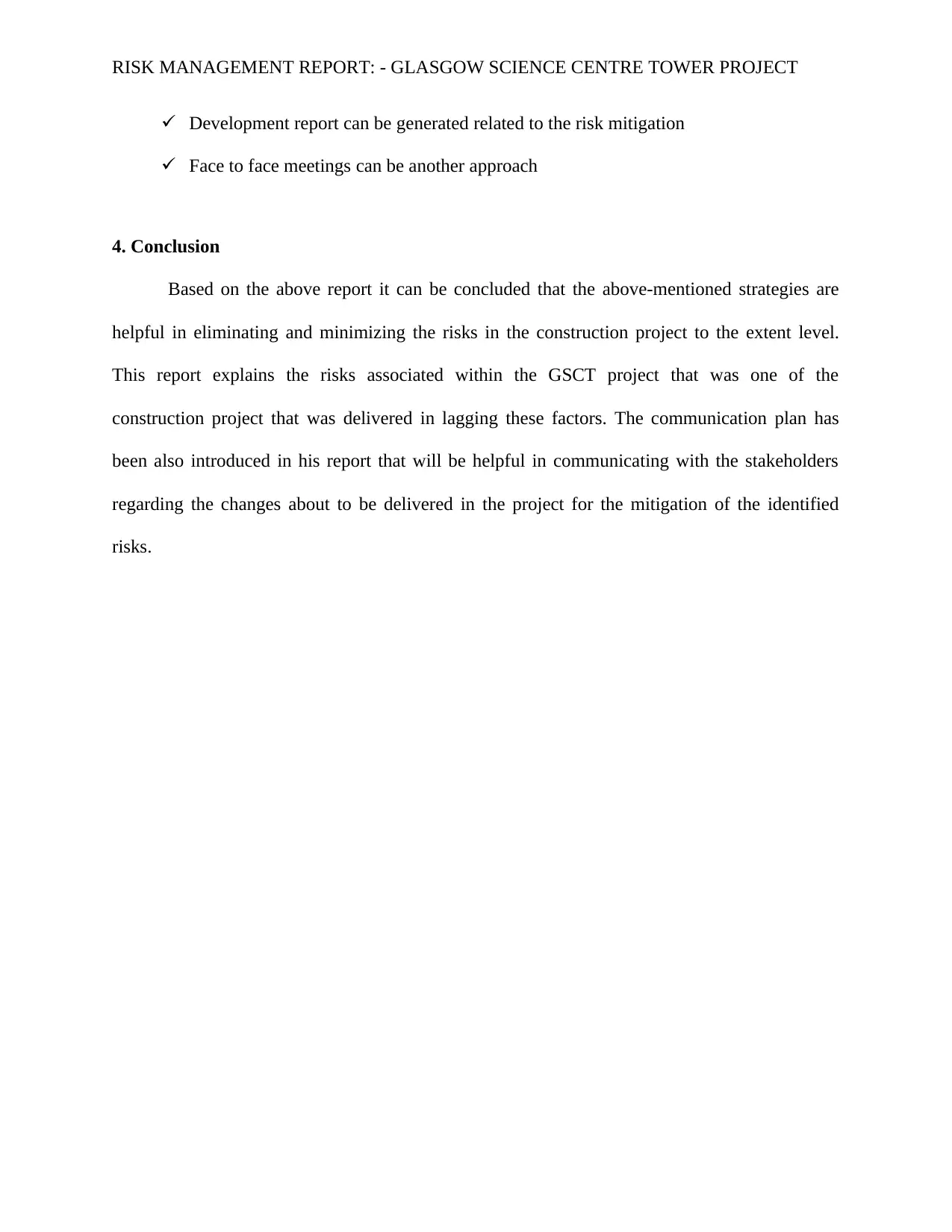
RISK MANAGEMENT REPORT: - GLASGOW SCIENCE CENTRE TOWER PROJECT
Development report can be generated related to the risk mitigation
Face to face meetings can be another approach
4. Conclusion
Based on the above report it can be concluded that the above-mentioned strategies are
helpful in eliminating and minimizing the risks in the construction project to the extent level.
This report explains the risks associated within the GSCT project that was one of the
construction project that was delivered in lagging these factors. The communication plan has
been also introduced in his report that will be helpful in communicating with the stakeholders
regarding the changes about to be delivered in the project for the mitigation of the identified
risks.
Development report can be generated related to the risk mitigation
Face to face meetings can be another approach
4. Conclusion
Based on the above report it can be concluded that the above-mentioned strategies are
helpful in eliminating and minimizing the risks in the construction project to the extent level.
This report explains the risks associated within the GSCT project that was one of the
construction project that was delivered in lagging these factors. The communication plan has
been also introduced in his report that will be helpful in communicating with the stakeholders
regarding the changes about to be delivered in the project for the mitigation of the identified
risks.
Paraphrase This Document
Need a fresh take? Get an instant paraphrase of this document with our AI Paraphraser
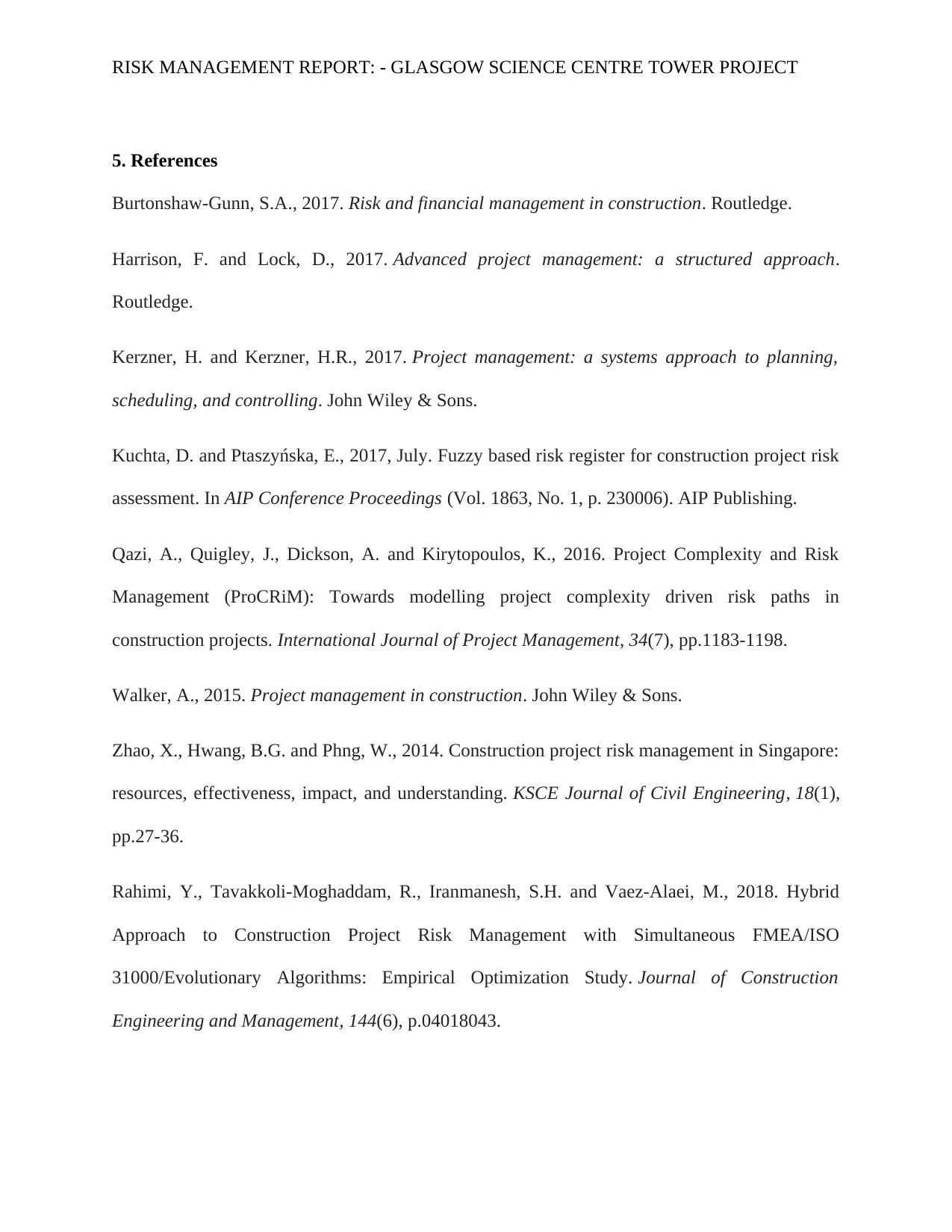
RISK MANAGEMENT REPORT: - GLASGOW SCIENCE CENTRE TOWER PROJECT
5. References
Burtonshaw-Gunn, S.A., 2017. Risk and financial management in construction. Routledge.
Harrison, F. and Lock, D., 2017. Advanced project management: a structured approach.
Routledge.
Kerzner, H. and Kerzner, H.R., 2017. Project management: a systems approach to planning,
scheduling, and controlling. John Wiley & Sons.
Kuchta, D. and Ptaszyńska, E., 2017, July. Fuzzy based risk register for construction project risk
assessment. In AIP Conference Proceedings (Vol. 1863, No. 1, p. 230006). AIP Publishing.
Qazi, A., Quigley, J., Dickson, A. and Kirytopoulos, K., 2016. Project Complexity and Risk
Management (ProCRiM): Towards modelling project complexity driven risk paths in
construction projects. International Journal of Project Management, 34(7), pp.1183-1198.
Walker, A., 2015. Project management in construction. John Wiley & Sons.
Zhao, X., Hwang, B.G. and Phng, W., 2014. Construction project risk management in Singapore:
resources, effectiveness, impact, and understanding. KSCE Journal of Civil Engineering, 18(1),
pp.27-36.
Rahimi, Y., Tavakkoli-Moghaddam, R., Iranmanesh, S.H. and Vaez-Alaei, M., 2018. Hybrid
Approach to Construction Project Risk Management with Simultaneous FMEA/ISO
31000/Evolutionary Algorithms: Empirical Optimization Study. Journal of Construction
Engineering and Management, 144(6), p.04018043.
5. References
Burtonshaw-Gunn, S.A., 2017. Risk and financial management in construction. Routledge.
Harrison, F. and Lock, D., 2017. Advanced project management: a structured approach.
Routledge.
Kerzner, H. and Kerzner, H.R., 2017. Project management: a systems approach to planning,
scheduling, and controlling. John Wiley & Sons.
Kuchta, D. and Ptaszyńska, E., 2017, July. Fuzzy based risk register for construction project risk
assessment. In AIP Conference Proceedings (Vol. 1863, No. 1, p. 230006). AIP Publishing.
Qazi, A., Quigley, J., Dickson, A. and Kirytopoulos, K., 2016. Project Complexity and Risk
Management (ProCRiM): Towards modelling project complexity driven risk paths in
construction projects. International Journal of Project Management, 34(7), pp.1183-1198.
Walker, A., 2015. Project management in construction. John Wiley & Sons.
Zhao, X., Hwang, B.G. and Phng, W., 2014. Construction project risk management in Singapore:
resources, effectiveness, impact, and understanding. KSCE Journal of Civil Engineering, 18(1),
pp.27-36.
Rahimi, Y., Tavakkoli-Moghaddam, R., Iranmanesh, S.H. and Vaez-Alaei, M., 2018. Hybrid
Approach to Construction Project Risk Management with Simultaneous FMEA/ISO
31000/Evolutionary Algorithms: Empirical Optimization Study. Journal of Construction
Engineering and Management, 144(6), p.04018043.
1 out of 8
Related Documents
Your All-in-One AI-Powered Toolkit for Academic Success.
+13062052269
info@desklib.com
Available 24*7 on WhatsApp / Email
![[object Object]](/_next/static/media/star-bottom.7253800d.svg)
Unlock your academic potential
Copyright © 2020–2025 A2Z Services. All Rights Reserved. Developed and managed by ZUCOL.

